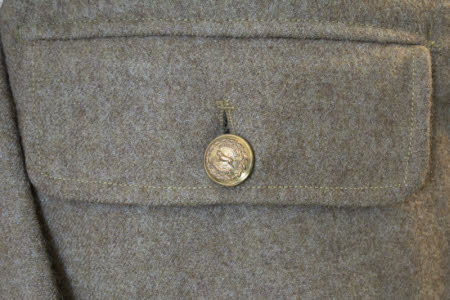Uniform
Category
Costume
Date
Unknown
Materials
Wool & Metal
Measurements
750 mm (Width) x 511 mm (Depth)
Order this imageCollection
Mr Straw's House, Nottinghamshire
NT 744205
Caption
By the First World War, the British Army had transitioned from red to khaki uniforms in response to new technologies: aerial reconnaissance and smokeless guns were making soldiers’ visibility a real problem on the battlefield. Before the war, Germany was the centre of the synthetic dyestuffs industry. By 1913, it was exporting more than 20 times the volume of dyes coming out of Britain. During the First World War the only khaki dye available for British Army uniforms was manufactured in Germany, which, at first, it secretly imported. Legally, a man could not wear his uniform more than 28 days after discharge, so upon demobilisation they were supplied with civilian suits by the Royal Army Clothing Department. Before he left his unit, each man was given a plain clothes form and a certificate of employment. The army issued a total of 1,413,760 suits to demobilised men at the end of the war, in dark blue, brown or grey.
Summary
Green khaki woollen army jacket, Leicestershire regiment buttons to front opening, pockets and shoulders, LEICESTERSHIRE shoulder titles on shoulder straps, flag badge to bottom of proper left sleeve. With trousers. Paper size label to inside of jacket proper right front, reads 'S.D JACKETS. Size No. 03, Height 5ft. 3 & 4, Breast 32 to 33, Waist 29, 8TRA....AN. ...RERAB & JONES, 1917'. Kept with green khaki woollen army trousers, four metal buttons to front waist line and two metal buttons to back waist-line, two waist/side pockets, cream cotton linings to pockets and waistband. Remnant of paper sizing label to proper left hip.
Provenance
Straw collection bequeathed to The National Trust on the death in 1990 of William Straw.


































